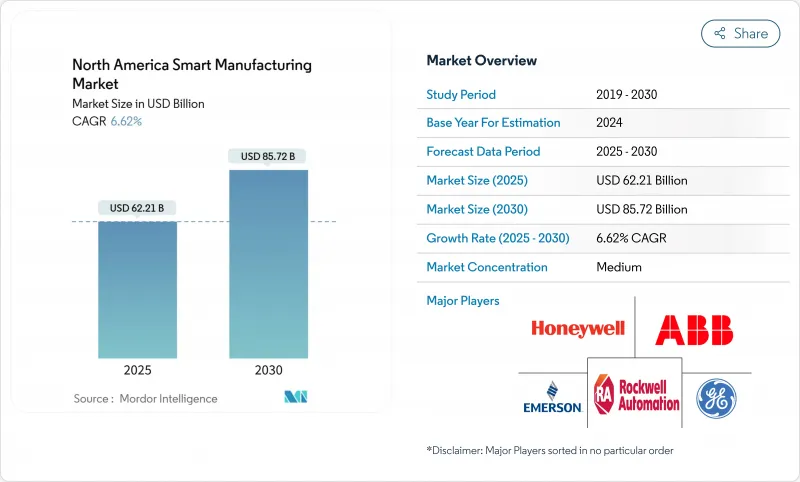
|
市場調査レポート
商品コード
1851470
北米スマート製造:市場シェア分析、産業動向、統計、成長予測(2025年~2030年)North America Smart Manufacturing - Market Share Analysis, Industry Trends & Statistics, Growth Forecasts (2025 - 2030) |
||||||
カスタマイズ可能
適宜更新あり
|
|||||||
| 北米スマート製造:市場シェア分析、産業動向、統計、成長予測(2025年~2030年) |
|
出版日: 2025年07月08日
発行: Mordor Intelligence
ページ情報: 英文 120 Pages
納期: 2~3営業日
|
概要
北米スマート製造市場は2025年に622億1,000万米ドルに達し、2030年には857億2,000万米ドルに達すると予測され、CAGR 6.62%で進展します。

その勢いは、連邦政府による記録的なインセンティブ、民間部門の強力な資本形成、ディスクリートおよびプロセス産業全体にわたる人工知能、5G、サイバーフィジカルシステムの緊密な結合に起因しています。製造業者の93%以上が2024年に新たなAIイニシアチブを立ち上げており、予測的で自己最適化可能な生産環境がパイロットから大規模な展開へと移行しつつあることを示しています。半導体のリショアリング、自動車の電動化の義務化、バッテリーのサプライチェーン構築などが需要を支える一方、製薬やライフサイエンス施設では厳しいコンプライアンス要件に対応するためのアップグレードが加速しています。また、北米スマート製造市場は、熟練工の減少やサイバー保険料の高騰など、労働力の力学の変化によっても形成されており、中堅・中小企業における導入速度が抑制されています。
北米スマート製造市場の動向と洞察
米国のディスクリート製造業でAIを活用したエッジ分析の導入が急増
AIアルゴリズムが機械層に組み込まれ、計画外のダウンタイムを最大60%削減し、資産寿命を20%延長する予知保全が可能に。クリーン・エネルギー・スマート・マニュファクチャリング・イノベーション・インスティテュートは、労働力プログラムを通じてこれらのツールへのアクセスを拡大し、データサイエンスのスキルギャップを埋める手助けをしています。メーカー各社は、ミリ秒レベルの応答が品質を左右する自動車や航空宇宙分野のレイテンシーに敏感なアプリケーションでは、現場でのデータ処理が不可欠であると考えています。
カナダの工場で5Gを利用した産業用IoTネットワークが急速に普及
米国のある鉄鋼施設では、5G LANソリューションの採用後、操業中断が70分の1に減少し、年間200万米ドルの節約を記録しました。製造業はすでに、世界中で発表されているプライベート5G導入の46%を占めています。カナダ無線通信協会は、5Gは2025年までに国の排出量を12.2 MtCO2e削減できると予測しています。
根強いOTサイバー保険料の高騰がデジタル転換を阻む
ランサムウェア事件は2024年に製造業者の65%に影響を与え、接続資産を導入する企業の保険料を30%以上押し上げます。多くの工場では依然として継続的なOT監視が行われておらず、認識されているリスクプロファイルと実際のリスクプロファイルのギャップが拡大しています。
セグメント分析
プログラマブル・ロジック・コントローラは、2024年に22%の売上を占め、何千ものプラントの制御レイヤーを支えています。しかし、協働ロボットの市場規模は、メーカーが人間とロボットの安全な協働を優先しているため、CAGR 8.6%で上昇すると予測されます。OTTO Motorsの自律移動ロボットのような導入は、11ヶ月の投資回収を実現し、安全事故を起こすことなく作業セルの設置面積を15%縮小します。
ハイブリッド・エッジ・ツー・クラウド・アーキテクチャでは、PLCとAI推論エンジンの統合が進んでいます。ロックウェル・オートメーションとエヌビディアは、オペレータが品質検査フローにジェネレーティブAIを適用できるリファレンスデザインを共同開発しています。マシンビジョンは現在、欠陥ゼロ保証のためにニューラルネットワークを組み込んでおり、製品ライフサイクル管理ツール内のデジタルツインは、物理的な実行前にプロセスの微調整を仮想的にテストするのに役立っています。
2024年の支出額の55%を制御ハードウェアが占めるが、2030年までのCAGRはソフトウェアとサービスが10%で上回ると予測されます。メーカー各社は、アナリティクス、サイバーセキュリティ、継続的最適化をバンドルしたサブスクリプションモデルを採用する傾向を強めており、Time-to-Valueの短縮を図っています。通信インフラ、特にプライベート5GとTime-Sensitive Networking Ethernetは、この軸足を支え、産業用IoTのスケーラビリティをサポートします。
高度なビジョンセンサは、この移行にスポットライトを当てます。コグネックスのIn-Sight L38 3Dシステムは、AIとデュアルモードイメージングを組み合わせ、トレーニングデータの必要性を最小限に抑えることで導入を加速します。また、MES 4.0フレームワークはITとOTデータレイクを統合し、在庫を30%削減し、従業員1人当たりの売上を75%増加させる。
北米スマート製造市場シェアレポートは、技術別(PLC、SCADA、その他)、コンポーネント別(制御装置、通信インフラ、その他)、エンドユーザー産業別(自動車、石油・ガス、その他)、導入形態別(オンプレミス、クラウド、その他)、国別(米国、カナダ)に分類されています。市場規模および予測は金額(米ドル)で提供されます。
その他の特典:
- エクセル形式の市場予測(ME)シート
- 3ヶ月間のアナリストサポート
よくあるご質問
目次
第1章 イントロダクション
- 調査の前提条件と市場の定義
- 調査範囲
第2章 調査手法
第3章 エグゼクティブサマリー
第4章 市場情勢
- バリュー/サプライチェーン分析
- 規制と技術の見通し(北米)
- 投資分析(資本フロー、MandA、ベンチャー資金調達)
- マクロ経済イベントの影響(COVID-19、貿易政策、労働力不足)
- 市場促進要因
- 米国のディスクリート製造業でAI対応エッジアナリティクスの導入が急増
- カナダの工場で5Gを利用した産業用IoTネットワークが急速に普及
- リショアリング奨励金(CHIPSと科学法、IRA)がデジタル・ファーストの工場を促進
- 持続可能性の義務化により、ブラウンフィールド・サイトでのスマートなエネルギー管理改修が推進される
- 自動車クラスターにおける不良品ゼロ生産のためのサイバーフィジカルシステムの採用
- 中小企業の加工工場でモジュラー、ローコードMESの需要が拡大
- 市場抑制要因
- デジタル転換を阻むOTサイバー保険料の高止まり
- レガシーPLC設置ベースにおけるマルチベンダー相互運用性のギャップ
- ティア2自動車部品メーカーにおけるインフレによるCAPEX延期
- 北米の熟練工の減少がスキルアップパイプラインを上回る
- ポーターのファイブフォース分析
- 供給企業の交渉力
- 買い手の交渉力
- 新規参入業者の脅威
- 代替品の脅威
- ライバルの激しさ
第5章 市場規模と成長予測
- 技術別
- 監視制御およびデータ収集(SCADA)
- 分散型制御システム(DCS)
- ヒューマン・マシン・インターフェース(HMI)
- 製造実行システム(MES)
- 製品ライフサイクル管理(PLM)
- 企業資源計画(ERP)
- ロボット工学と協働ロボット
- マシンビジョンと品質検査
- エッジおよびクラウド分析プラットフォーム
- コンポーネント別
- 制御機器(PLC, DCS, PAC)
- 通信インフラ(5G、産業用イーサネット)
- センサーとアクチュエーター
- マシンビジョンシステム
- ロボット(多関節、スカラ、AMR)
- ソフトウェアとサービス(MES、デジタルツイン、SaaS)
- エンドユーザー業界別
- 自動車
- 航空宇宙・防衛
- 石油・ガス(上流、中流、下流)
- 化学および石油化学
- 製薬・ライフサイエンス
- 飲食品
- 金属・鉱業
- 電子・半導体
- パルプ・製紙
- その他(繊維、プラスチック)
- 展開モード別
- オンプレミス
- クラウド(SaaS)
- ハイブリッド
- 国別
- 米国
- カナダ
- メキシコ
第6章 競合情勢
- 戦略的な動き(パートナーシップ、リショアリング、ESG連動融資)
- 市場シェア分析
- 企業プロファイル
- ABB Ltd.
- Emerson Electric Co.
- FANUC Corp.
- General Electric Co.
- Honeywell International Inc.
- Mitsubishi Electric Corp.
- Robert Bosch GmbH(Bosch Rexroth)
- Rockwell Automation Inc.
- Schneider Electric SE
- Siemens AG
- Texas Instruments Inc.
- Yokogawa Electric Corp.
- Omron Corp.
- PTC Inc.
- IBM Corp.
- Cisco Systems Inc.
- SAP SE
- Dassault Systemes SE
- Cognex Corp.
- Keyence Corp.
- Stratasys Ltd.

